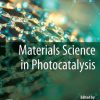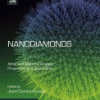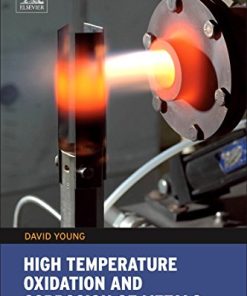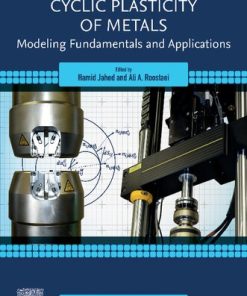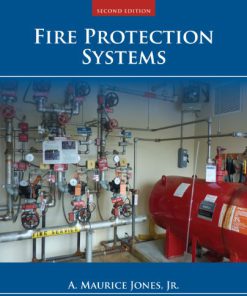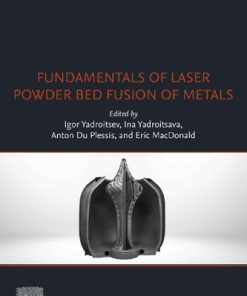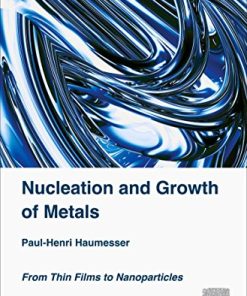(Ebook PDF) Electrocorrosion and Protection of Metals 2nd Edition by Joseph Riskin, Alexander Khentov 0444640223 9780444640222 full chapters
$50.00 Original price was: $50.00.$25.00Current price is: $25.00.
Electrocorrosion and Protection of Metals 2nd Edition by Joseph Riskin, Alexander Khentov – Ebook PDF Instant Download/DeliveryISBN: 0444640223, 9780444640222
Full dowload Electrocorrosion and Protection of Metals 2nd Edition after payment.
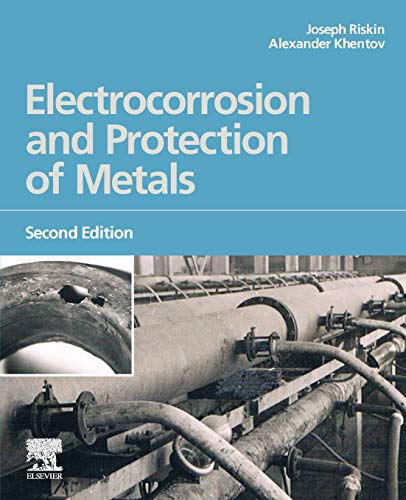
Product details:
ISBN-10 : 0444640223
ISBN-13 : 9780444640222
Author: Joseph Riskin, Alexander Khentov
Electrocorrosion and Protection of Metals, Second Edition, compiles theoretical and practical information, outlines the specific problem, and presents the available solutions related to corrosion by external currents. Basic data on the behavior of different metals under the attack of anodic, cathodic, direct and alternating currents is considered, as are the problems of electrocorrosion—from the identification of corrosion damage and detection of the external current sources, to the selection of optimal means and methods of mitigation, monitoring and protection of different metallic structures and structures of reinforced concrete.
Electrocorrosion and Protection of Metals 2nd Table of contents:
1- Corrosion and Electrocorrosion of Metals. Corrosion by Stray Currents and Protection Methods
1 – Corrosion Basics
1.1 Types of Corrosion Cell
1.1.1 Galvanic Cell
1.1.2 Concentration Cell
1.1.3 Differential Temperature Cell
1.1.4 Electrolytic Cell
1.2 Electrode Potential, Electromotive Force Series and Diagrams Potential-pH
1.3 Spontaneous Polarization of Metals, Polarization Diagram
1.4 Polarization Curves, Passivity of Metals
1.5 Types of Corrosion
1.5.1 Uniform Corrosion
1.5.2 Localized Corrosion
1.5.2.1 Pitting
1.5.2.2 Crevice Attack
1.5.3 Galvanic Corrosion
1.5.4 Microbiologically Influenced Corrosion
1.5.5 Undercoating Corrosion
1.5.6 Stress-Corrosion Cracking
1.5.7 Hydrogen Damage
1.5.8 Corrosion of Steel in Concrete
1.5.9 Corrosion in Soil
1.6 Main Methods of Corrosion Protection
1.6.1 Protective Coatings
1.6.2 Basics of Cathodic Protection
References
2 – Corrosion Behavior of Metals Under the Attack by External Currents
2.1 External Current as a Factor of the Environment Aggressiveness
2.2 Attack of External Anodic Current on Actively Corroding Metals
2.3 Attack of External Anodic Current on Passive Metals
2.4 Influence of External Anodic Current on Thermodynamically Stable Metals
References
3 – Sources of Underground and Underwater Stray Currents
3.1 Underground Stray Currents From Electrified Railways
3.2 Underground Stray Currents From Mining Operations
3.3 Underground Stray Currents From Cathodic Protection Systems
3.4 Underground and Underwater Stray Currents From High Voltage Direct Current (HVDC) Transmissions
3.5 Underground and Underwater Stray Currents From Welding Operations and From Other Sources
3.5.1 Underground Stray Currents
3.5.2 Underwater Stray Currents
3.5.2.1 Offshore Platforms
3.5.2.2 Welding Operations From Costal and Offshore Power Sources and Other Stray Current Sources at
3.6 Stray Currents From Alternative Renewable Energy Sources
3.6.1 Solar Farms
3.6.2 Wind Farms
3.7 Telluric Currents
3.8 Lightning
3.9 Stray Currents of Cathodic Direction
References
4 – Detection, Identification and Estimation of Stray Currents
4.1 Stray Current Corrosion Identification Without Resort to Special Measurement Instruments
4.2 Detection and Estimation of Stray Currents by Measurements of Metal – Soil Potential and of Volt
4.2.1 Instruments and Techniques of Potential Measurements
4.2.2 Detection of Stray Currents Presence on Unprotected Underground Structures
4.2.3 Measurements of Soil Resistivity
4.2.4 Estimation of Static Stray Current Values on Unprotected Underground Pipelines by Potential Di
4.2.5 Direct Measurements of Static Stray Current Along Unprotected Pipelines
4.2.6 Finding Dynamic Stray Current Direction on Unprotected Pipelines by Repeated Measurements
4.2.7 Detection of Stray Currents and Their Sources on Protected Pipelines
4.2.8 Detection of Well Casing Stray Currents
4.2.9 Detection of Telluric Currents
References
5 – Objects of Attack by Stray Currents
5.1 Extended Objects of Stray Current Attack
5.1.1 Rails
5.1.2 Pipelines
5.1.3 Cables
5.2 Storage Tanks
5.3 Structures of Reinforced Concrete
5.4 Radiators and Other Parts of Vehicle Cooling Systems
5.5 Stray Current Corrosion of Insulated Parts of Cathodically Protected Objects
References
6 – Protection From Stray Current Corrosion
6.1 Passive Methods of Prevention and Mitigation of Stray Current Corrosion
6.1.1 Mitigation of Stray Currents From Rails
6.1.2 Possibilities of Mitigation of Stray Currents Coming From Cathodic Protection Systems
6.1.3 Possibilities of Mitigation of Stray Currents Coming From HVDC Transmission Lines
6.1.4 Prevention and Mitigation of Stray Currents From Welding Operations and From Other Sources at
6.1.5 Mitigation of Stray Current Attack by Coating
6.1.6 Mitigation of Stray Current Attack in Reinforced Concrete Structures
6.2 Electrical Methods of Protection From Stray Current Corrosion
6.2.1 Protection From Stray Currents Arriving From Cathodic Protection Systems by Electrical Drainag
6.2.2 Protection by Electrical Drainage Bond Against Stray Currents Arriving From Electrical Tractio
6.2.3 Cathodic Protection by Impressed Current in Combination With Drainage System
6.3 Cathodic Protection in the Field of Stray Current
6.4 Protection From Stray Current Attack by Sectionalization of Pipelines in Combination With Other
6.5 Protection From Stray Current Corrosion at the Stage of Design
6.6 Maintenance, Control, and Monitoring in the Systems of Protection From Stray Current Corrosion
References
7 – Corrosion Induced by Alternating Current
7.1 Sources of AC Interference
7.2 Modes of AC Interference
7.2.1 Capacitive Coupling
7.2.2 Conductive Coupling
7.2.3 Inductive Coupling
7.3 Likelihood of AC Corrosion
7.3.1 Likelihood of AC Corrosion in Concrete
7.4 AC Corrosion and Cathodic Protection
7.5 Mechanism of AC Corrosion
7.6 Morphology of AC Corrosion Damage
7.7 AC Corrosion Identification
7.8 AC Effects on Different Metals
7.9 Mitigation of AC Corrosion
7.9.1 Mitigation of Damage from Powerline Fault
7.9.2 Mitigation of Consequences of Electrostatic Interference
7.9.3 Mitigation of Consequences of Electromagnetic Coupling
7.9.4 The Grounding Arrangement and Types of Electrodes
7.10 Monitoring of AC Corrosion
References
2 – Corrosion by Leakage Currents in Electrochemical Plants and Protection Methods
8 – Operating Features of Electrochemical Plants
8.1 General Characteristics of Electrochemical Plants
8.2 Leakage Currents in Electrochemical Plants
8.2.1 Sources of Leakage Currents, Concepts, and Problems Connected With Them
8.2.2 Methods of Measuring and Controlling Leakage Currents
8.2.3 Magnitudes and Distribution Regularity of Leakage Currents along the Lines of Electrochemical
8.3 Aggressive Media
References
9 – Using Structures of Metallic Materials in Electrochemical Plants Without Taking Into Account Att
9.1 Nonmetallic Materials
9.2 Traditional Metallic Materials
9.3 Experience in the Field of Titanium Application
9.3.1 Preconditions for the Application of Titanium in Electrochemical Plants
9.3.2 Attempts of Titanium Application in the Zones of Attack by Leakage Currents
9.3.3 Preconditions and Experience of Titanium Application in Wet Chlorine Lines of Electrochemical
9.3.4 Laboratory and Industrial Tests of Titanium Resistance Against Crevice Corrosion in Wet Chlori
References
10 – Corrosion Behavior Investigations of Traditional Structural Metallic Materials in Electrochemic
10.1 Carbon Steel in Neutral, Alkaline, and Chloride-Alkali Media
10.1.1 Neutral Solutions of Salts
10.1.2 Alkaline Solutions
10.1.3 Chloride-Alkali Solutions
10.2 Stainless Steel 18-10 in Alkaline and Acid Media
10.2.1 Solution of 50% NaOH at 120°C; Comparison of Corrosion Behavior of Stainless Steel 18-10 and
10.2.2 Technological Solution for Producing Sodium Perborate
10.2.3 Acid Sulfate Containing Electrolyte for Copper Electrorefining
References
11 – Corrosion Behavior Investigations of Titanium and Its Alloys in the Media of Electrochemical Pl
11.1 Corrosion and Electrochemical Characteristics of Titanium
11.2 Chloride and Chloride-Alkali Media of Chlorine- Producing Electrochemical Plants
11.3 Electrolyte for Copper Electrorefining
11.4 Media of Nickel Electrorefining
11.5 Influence of Welding Seams and Crevices
11.5.1 Welding Seams
11.5.2 Artificial Crevices
11.6 Titanium Alloys
References
12 – Hydrogenation and Corrosion Investigations of Titanium Under Attack by an External Cathodic Cur
12.1 Conditions of Hydrogenation and Corrosion of Titanium: Methodological Features of Experiments
12.2 Investigations in Non-Stirred NaCl Solutions
12.3 Investigations Under Conditions of Electrolyte Stirring and Flowing
12.3.1 Relation Between the Corrosion Rate of Titanium and the Accumulation of Oxygen–Chlorine Com
12.3.2 Two Corrosion Mechanisms of Hydrogenated Titanium
12.4 Welding Seams
12.5 Hydrogenation of Cathode Blanks in Solution of Nickel Electrorefining
12.5.1 Electrochemical Investigations of Combined Discharge of Nickel and Hydrogen Ions on Titanium
12.5.2 Radiochemical Investigations of Titanium Hydrogenation in the Process of Nickel Deposition
References
13 – Estimation of Corrosion Stability of Structures Made of Passive Metals in Aggressive Media, in
13.1 Estimation Based on the Potential Value
13.1.1 Activation Potential as an Estimation Criterion of the Passive Metal State in the Field of an
13.1.2 Types of Structural Elements in the Form of Tubes in the Field of an External Current
13.1.3 Potential and Current Distribution Along Structural Elements in the Form of Tubes
13.1.3.1 Bipolar Tube
13.1.3.2 Monopolar Tube
13.1.3.3 Semiinfinite Tube
13.1.4 Procedure for Computation of the Potential Distribution Along the Internal Tube Surface With
13.2 Estimation Based on the External Current Value
13.2.1 Estimation Based on the External Current Value for Tube-Shaped Structural Elements
13.2.1.1 Semi-infinite Tube
13.2.1.2 Bipolar Tube
13.2.1.3 Monopolar Tube
13.3 Practical Steps and Examples of Corrosion Stability Estimation of Structures in the Form of Tub
13.4 Significance of the Electrochemical Characteristics of Passive Metals for the Estimation and Pr
References
14 – Electrocorrosion Protection of Metals in Electrochemical Plants Based on Existing Methods
14.1 Insulating Coatings
14.2 Reduction of Leakage Currents Coming From Electrochemical Cells
14.2.1 Reduction of Leakage Currents Along Electrolyte Piping and Prevention of Current Oscillations
14.2.2 Reduction of Leakage Currents Along Piping of Wet Gases
14.3 Sectionalization of Piping Made of Passive Metals
14.4 Possibilities of Applying “Traditional” Methods of Electrochemical Protection and Their Mod
14.4.1 Electrodrainage Protection
14.4.2 Protection by Sacrificial Anodes for Current Drainage in Chloride Electrolysis Plants
14.4.3 Protection by Sacrificial Anodes for Current Drainage in Electrolysis Plants With Metal Depos
References
15 – New Principles of Protection of Passive Metals Against Electrocorrosion in Electrochemical Plan
15.1 Protection of Metals With the Relationship Δ=Eox−EA<0, Against Corrosion Attack by an Extern
15.1.1 Theoretical Basis
15.1.2 Experimental Verification of the Protection Principle
15.2 Corrosion Protection With the Help of Dimensionally Stable Anodes, Oriented Along the Field of
15.2.1 Theoretical Basis
15.2.2 Investigation of the Protection Principle
15.3 Protection of Metals Against Corrosion Attack by an External Cathodic Current
15.4 Protection of Metals Against Corrosion Attack by Leakage Currents That Periodically Change Thei
15.5 Protection of Metals Against Corrosion Attack by External Currents at the Design Stage
References
16 – Electrodes for Metal Protection Against Corrosion Attack by Leakage Currents in Electrochemical
16.1 Requirements Upon Materials of Electrodes That Are Used for Protection Against Corrosion Attack
16.2 Application of Anodes of Commercial Electrolysis Processes for Protection Against Electrocorros
16.2.1 Neutral and Acid Chloride-Containing Media
16.2.2 Chloride-Sulfate Media
16.3 Anodes for Media Containing Sulfuric Acid
16.4 Dimensionally Stable Anodes With a Coating Obtained on the Basis of Intermetallic Compounds Pro
16.4.1 Preconditions for the Choice of Materials and Methods of Producing the Anodes: Test Condition
16.4.2 Investigations in Chloride Solutions
16.4.3 Investigations in Chloride-Alkali Solutions
16.5 Stable Cathodes
16.5.1 Cathodes for Media Containing Dissolved Chlorine and for Chloride Media
16.5.2 Titanium Cathodes for Other Aggressive Media
16.5.3 Possibilities of Increasing the Stability of Titanium Cathode Blanks
References
17 – Industrial Tests and the Introduction Into Electrochemical Plants of the Developed Methods for
17.1 Protection by Sacrificial Anodes in Electrorefining Plants
17.1.1 Industrial Tests
17.1.2 Introduction of the Protection in a Copper Electrorefining Plant
17.2 Industrial Tests and the Introduction of Corrosion Protection by Current Leak-Off Anodes to Tit
17.2.1 Industrial Tests
17.2.2 Introduction of Protection
17.3 Industrial Tests and the Introduction of Corrosion Protection by Anodes Oriented Along the Fiel
17.3.1 Industrial Tests
17.3.2 Introduction of Protection
17.4 Industrial Tests of Titanium Protection Against Corrosion Attack by Cathodic Leakage Currents W
17.5 Combined Protection of Metals Against Corrosion Attack by Leakage Currents
17.6 Effectiveness and Possibilities of Using the Developed Methods of Metal Protection Against Elec
People also search for Electrocorrosion and Protection of Metals 2nd:
how can we protect metal from corrosion
how to protect metal from corrosion
what metal is used to prevent corrosion
electrochemical corrosion potential
electrical corrosion protection
You may also like…
Jurisprudence & Law - Foreign & International Law
The Law of International Human Rights Protection 2nd Edition Walter Kälin
Technique - Materials
Cyclic Plasticity of Metals: Modeling Fundamentals and Applications 1st Edition
Uncategorized
Uncategorized
Engineering - Electrical & Electronic Engineering


